

Old Chinese Proverbs and Idioms - Cheng Yu Pinyin with English. Chinese Idioms - Chinese sayings can be divided into two categories: proverbs (yan yu, see information on proverbs below), and idioms, (cheng yu).
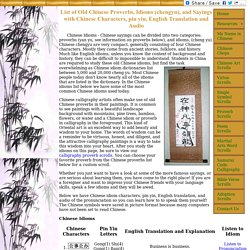
Chinese chengyu are very compact, generally consisting of four Chinese characters. Mostly they come from ancient stories, folklore, and history. Much like English idioms, unless you know the context of background and history, they can be difficult to impossible to understand. Students in China are required to study these old Chinese idioms, but find the task overwhelming as Chinese idiom dictionaries list between 5,000 and 20,000 cheng yu. Chinese calligraphy artists often make use of old Chinese proverbs in their paintings. Whether you just want to have a look at some of the more famous sayings, or are serious about learning them, you have come to the right place! Below we have Chinese idiom characters, pin yin, English translation, and audio of the pronunciation so you can learn how to to speak them yourself!
Chinese Proverbs about coping with situations. This loosely knit group of proverbs all have to do with dealing with a particular predicament.

Some of these just describe the situation without offering advice on how to deal with it. 冰天雪地 Bīng tiān xuě dì [bing tian xue di] ice sky snow ground Ice in the sky and snow on the ground. Encountering adverse conditions 步步高升 Bù bù gaō shēng [bu bu gao sheng] step step tall ascend Step by step promotion Congratulation on promotion or a new job 臭不可当 Choù bù kě dāng [chou bu ke dang] smelly not can equal Worst ever smell To give off an unbearable stink 穿新鞋,走老路 Chuān xīn xié, zǒu lǎo lù [chuan xin xie, zou lao lu] put on new shoes, walk old road Wear new shoes but follow old paths Stick to the old ways while appearing to follow the latest trends 度日如年 pass day as year. Cantonese Proverbs in One Picture. 阿塗(Ah To), a graphic designer and part-time cartoonist who concerns about the survival of Cantonese in Canton and Hong Kong, has just published a comic called ” The Great Canton and Hong Kong Proverbs” on Hong Kong independent media “Passion Times“.
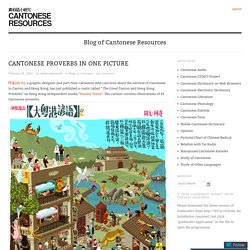
The cartoon contains illustrations of 81 Cantonese proverbs. “The Great Canton and Hong Kong Proverbs” In 1559, Dutch artist Pieter Bruegel created the oil painting “Netherlandish Proverbs” which illustrates many Dutch proverbs to praise the Dutch culture. In 2014, Ah To imitated the idea and created “Great Canton and Hong Kong proverbs” illustrating 81 Cantonese proverbs to propagate the Cantonese culture and defend Cantonese. 81 Cantonese Proverbs (The 2 extra proverbs are the bonus given by the author. The poster is now available at Passion Times, click here. Like this: Chinese proverbs. This is a collection of Chinese proverbs (諺語 yànyŭ) and idioms (成語 chéngyŭ), given in and sorted by their pinyin transcription.
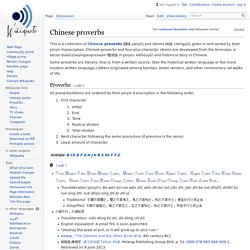
Chinese proverbs and four-plus character idioms are developed from the formulaic or social dialect/saying/expression (歇後語 in pinyin: xiēhòuyŭ) and historical story in Chinese. Some proverbs are literary; that is, from a written source. (See the historical written language or the more modern written language.) Others originated among families, street vendors, and other commoners--all walks of life. Proverbs[edit] All proverbs/idioms are ordered by their pinyin transcription in the following order.
First character InitialEndToneRadical strokesTotal strokesNext character following the same procedure (if previous is the same)Least amount of character Initials: B Ch D F G H J K R S Sh T Y Z. Dictionnaire des proverbes et chengyu chinois, avec traduction en pinyin, anglais et français. Ce service gratuit est proposé par Regine Traduction.
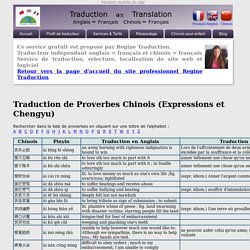
Traducteur indépendant anglais > français et chinois > françaisService de traduction, relecture, localisation de site web et logicielRetour vers la page d'accueil du site professionnel Regine Traduction Rechercher dans la liste de proverbes en cliquant sur une lettre de l'alphabet : A B C D E F G H J K L M N O P Q R S T W X Y Z Revenir en haut de la liste de proverbes chinois. 一步一个脚印 - My mission from advanced Chinese learner to professional interpreter. Most advanced learners, I think, have a love-hate relationship with chengyu (成语), those pesky, mostly four-character idioms taken from classical China.
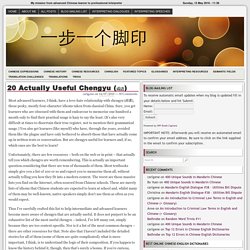
Sure, you get learners who are obsessed with them and endeavour to memorise one hundred a month only to find their practical usage is hazy to say the least. (It’s also very difficult at times to discertain their true register, not to mention their grammatical usage.) You also get learners (like myself) who have, through the years, avoided them like the plague and have only bothered to absorb those that have actually come up in written texts or conversation. But are chengyu useful for learners and, if so, which ones are the best to learn? Unfortunately, there are few resources – both on the web or in print – that actually tell you which chengyu are worth remembering. Thus I’ve carefully crafted this list to help intermediate and advanced learners become more aware of chengyu that are actually useful.
But why learn them at all? 1. 2. 3.